Early Seismic Experiments
Although seismicity had been observed in Socorro, the COCORP experiment over the Socorro magma body provided the first definite evidence of a mid-crustal reflector (Brown et al., 1979). The reflector is observed below at about 7 s.
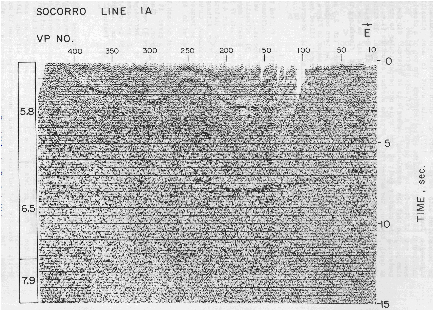
In 1965, Sanford and Long showed locations of microearthquakes around Socorro around a 6 station network. The earthquakes produced identifiable SzP and SzS
phases, which are reflected from the top of the magma body. The depth and thickness were originally estimated based on travel time curves of the two phases (time vs. S-P interval). Further refinement and investigation of the reflectors is extensively documented (Sanford et al., 1977, Brown et al., 1979, Ake and Sanford, 1988, Balch et al., 1997).
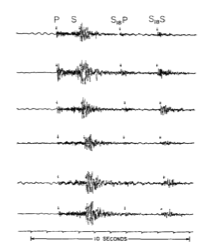
Sanford and Long, 1965. The figure shows seismograms from an earthquake. Note the SzP and SzS phases.
There were several studies that incorporated waveform modeling of body waves and teleseismic receiver function modeling to constrain the geographical extent and geometry of the magma body. Two of these studies focused on constraining the geometry of the magma body. A temporary deployment in 1993 and 1994 led to the observation of strong secondary P wave arrivals from teleseismic Tonga earthquakes at one station, TLW.
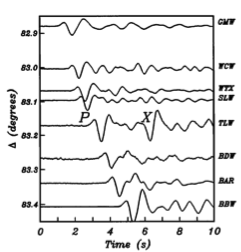
Schlue et al., 1996.
This phase was called X, and appeared on the vertical and east components. It was mostly reproduced by considering the following model:
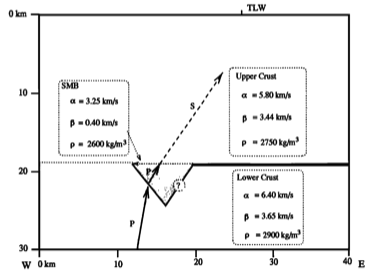
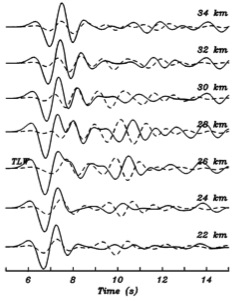
Schlue et al., 1996. Note station TLW. The second prominent conversion is a result of the model in the previous figure.
The root here is inferred to be in the Albuquerque basin and the authors suggest that it is a conduit for magma intrusion (Schlue et al., 1996). However older analysis of microearthquake PzP phases indicates a maximum thickness of ~500 m, although Ake and Sanford acknowledge that internal variations in the magma body structure exist. The thickness is now estimated at tens of meters (Pearse and Fialko, 2010). The geometry of the sill has also been studied using receiver functions. Synthetic receiver functions were generated with a model of a thin sill magma body that closely matched the observed receiver functions (Sheetz and Schlue, 1992). This does not preclude variations in thickness.
Current research focus is on defining the magma body uplift rate using InSAR and characterizing the seismicity, especially swarm activity.
InSAR
Fialko and Simons (2001) stacked interferograms to produce deformation over 7 years of the Socorro magma body. They modeled the magma body as two volumetrically increasing flat discs and reproduced the deformation observed by InSAR. The model parameters that were solved for were the radii of the discs, the coordinates of the discs, and the magma pressure needed to produce the uplift in an elastic crust. They observed a paradox between the relatively slow magma intrusion rate and the relatively fast magma freezing rate. In response to the paradox, it has been suggested that the Socorro magma body is younger than previously thought, it is thicker than previously thought, or the response of the crust is viscoelastic, which allows a larger injection volume with a similar surface response.
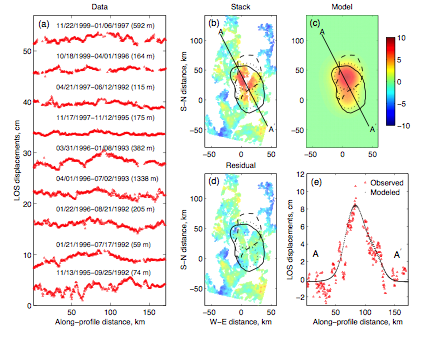
Fialko and Simons, 2001. On the left are the individual interferograms, which are stacked to produce b). Figure c) shows the modeled discs and the corresponding uplift. Figure d) shows the residual between the model and the data, note that the model accounts for the InSAR observed uplift. Figure e) shows the stacked interferogram.

Pearse and Fialko, 2010. Two models of the Socorro magma body which faithfully reproduce the InSAR observed uplift. The top figure shows an elastic crust while the bottom figure shows a crust with a power law rheology surrounding the magma body. These models are offered as solutions to the paradox.
Although the seismicity near the Socorro magma body has been observed since a magnitude 5 earthquake in 1906 (Sanford et al., 1977), two recent studies have made advances on location and characterization of Socorro magma body seismicity. The first, published in 2008 by Stankova et al., found 1600 earthquakes that occurred after a Ml 2.4 event. The swarm events took place at 6-7 km depth. Focal mechanisms for the Ml 2.4 earthquake showed a normal fault mechanism. Waveform cross-correlation between the master templates (P, S, and SzS) and the continuous data was used to identify the swarm earthquakes. The earthquakes were relocated relative to each other with correlated arrival picks.
Stankova et al., 2008. The lower panel shows the master event and the sum of the 1600 cross correlated events. This is the vertical component centered around the P wave arrival. The top panel are the 1600 aligned traces, where white colors represent the most highest valued positive amplitudes

The 2009 swarm contained 431 events with a Ml 2.5 earthquake, focused at 4-6 km. Based on comparison of b-values between magmatic settings and intercontinental settings, the authors conclude that there is no direct influence of magmatism on seismic activity, and perhaps changes in pore pressure related to injection of magma are causing the earthquakes. Future research may reveal whether earthquakes occur with coincident vertical uplift.

Ruhl et al., 2010. Cross section showing relocated events from the 2009 swarm. Note the shallow depth of the earthquakes.
Conclusions
The Socorro magma body has been thoroughly characterized as a flat magma body emplaced at 18.75 km depth which produces reflectors that can be observed from seismograms. The geometry of the underside of the sill and the mechanism for magma injection are not well understood.
InSAR results show a constant uplift rate of 2-3 mm/yr of the magma body. Possible solutions to the thermal paradox (magmatic freezing rate is greater than intrusion rate) include a younger emplacement age, viscoelastic response of the crust to the magma injection, and a thicker magma sill.
Seismicity associated with the magma body occurs at depths shallower than the emplacement of the magma body, and may be due to pore pressure changes or coincident uplift and volumetric increase due to magma injection. Double couple solutions generally show extension.